Week 16 Picks - Pressures and Stops
Usually I use this space in my weekly picks to talk about something that’s on my mind related to the Packers. Today we’re going in a little bit of a different direction as I want to introduce a new tool into our discussion about the Packers’ defense.
If you’ve listened to Blue 58 at all over the past couple of years, you know that pressures and the rate at which players generate those pressures are a big part of how we evaluate pass rushers. I don’t feel like I need to explain anything about why pressures are important or why they matter. However, I wondered if there was a way we could do the same sort of thing for evaluating run defense, and it turns out we can.
Pro Football Focus charts a metric they call “stops” in run defense. What’s a stop? It’s a tackle on a play that causes a play to be deemed unsuccessful analytically. How is that determined? Via success rate. What’s success rate? I’m glad you asked.
As defined by Pro Football Reference, success rate is a contextually dependent measure of how often an offense (or offensive player) succeeds at getting a useful amount of yards on a given play. PFR says this about what plays are considered successful: “...a successful play depends on the context. We define it as a play that gains at least 40% of yards required on 1st down, 60% of yards required on 2nd down, and 100% on 3rd or 4th down.”
A stop, then is a play that fails to gain the appropriate yards on the appropriate play, and if we divide the number of stops a player gets on run plays by the number of running plays they’re on the field to defend, we can generate stop rate in a similar way to how we generate pressure rate.
It’s simple enough, and although success rate has its criticisms, I think it at least gives us another fairly solid stat to add to our arsenal.
But here’s where the fun begins. If you chart pressure rate vs. stop rate, you can see a bunch of interesting things about the Packers defense. Showing who gets pressures frequently and who gets stops frequently tells us a lot about who’s doing well for the Packers, while also showing us different archetypes of players. Stop the run a lot and get lots of pressures? You’re an elite player. Get a lot of pressures but not many stops in the run? You’re useful in a different way. Pile up stops but don’t do much in the passing game? Hello, Mr. Run Stuffer.
I know I’m not the first to do this, but I think discussions like these are important as we evaluate the Packers’ defense, its players, and Joe Barry’s future in it. Here’s what the Packers’ stops vs. pressures chart looks like through 15 weeks.
A few things catch my eye here. First, Devonte Wyatt is a surprising stud here, putting up much better numbers against the run than I’d have guessed. His performance warrants further attention, but it’s encouraging to see him grow into his second year. Second, Rashan Gary is exactly who he looks like on film, as is TJ Slaton. Gary gets pressures but doesn’t stop the run, while Slaton stuffs the run but doesn’t do much in the passing game. Finally, Lukas Van Ness appears to already be growing into the exact player he was drafted to replace: his stats are almost identical to Preston Smith, and that’s precisely the kind of guy he needs to be in the future to pay off as a draft pick.
This isn’t a be-all, end-all stat, but again, nothing is, and I’m excited to iterate on it. In the future I’ll probably create versions of this that incorporate past Packers seasons or other noteworthy players from defensive fronts around the league. The more we can do to tell the story of the Packers’ defense, the better, both now and in the future.
To read the rest of this piece, support The Power Sweep on Patreon or Substack.

